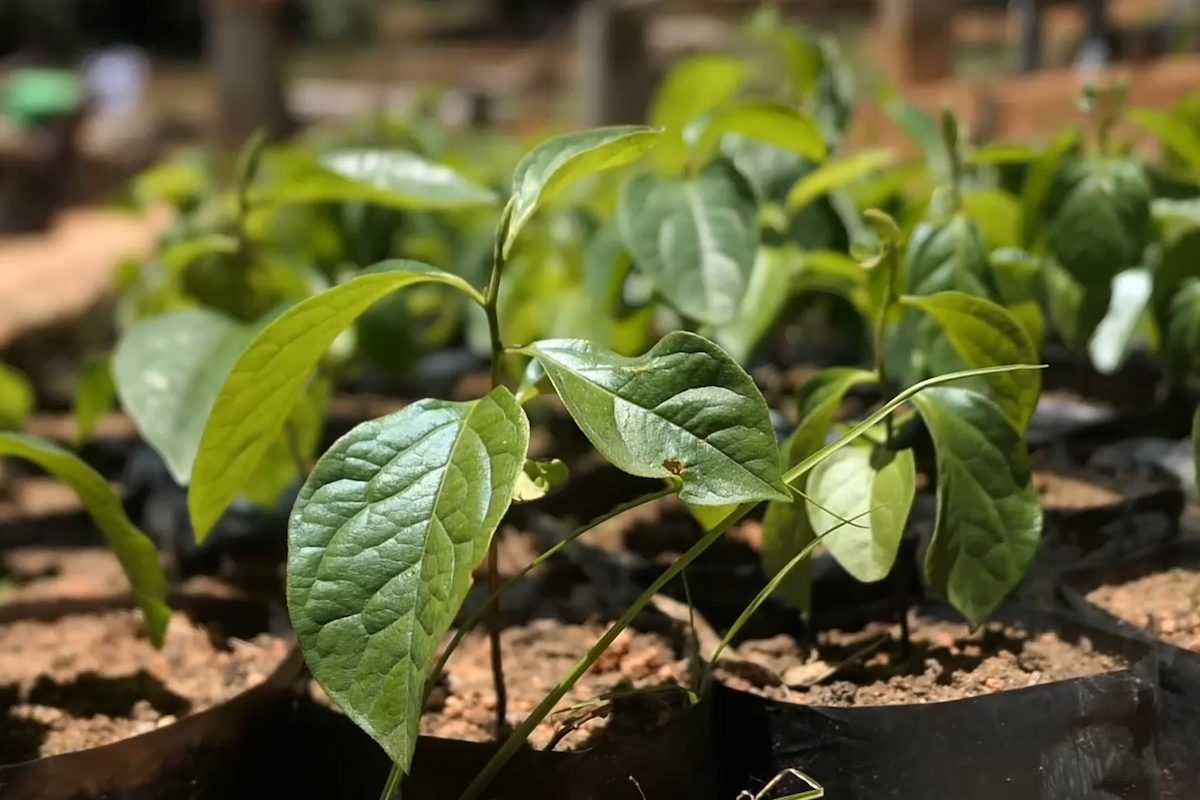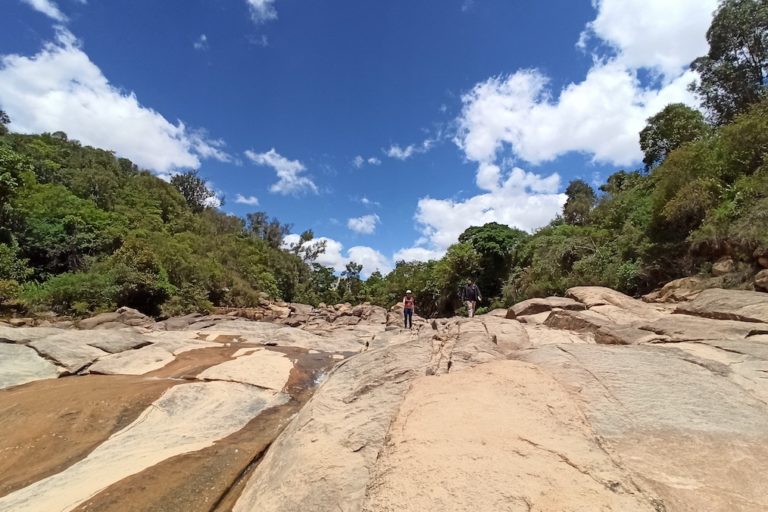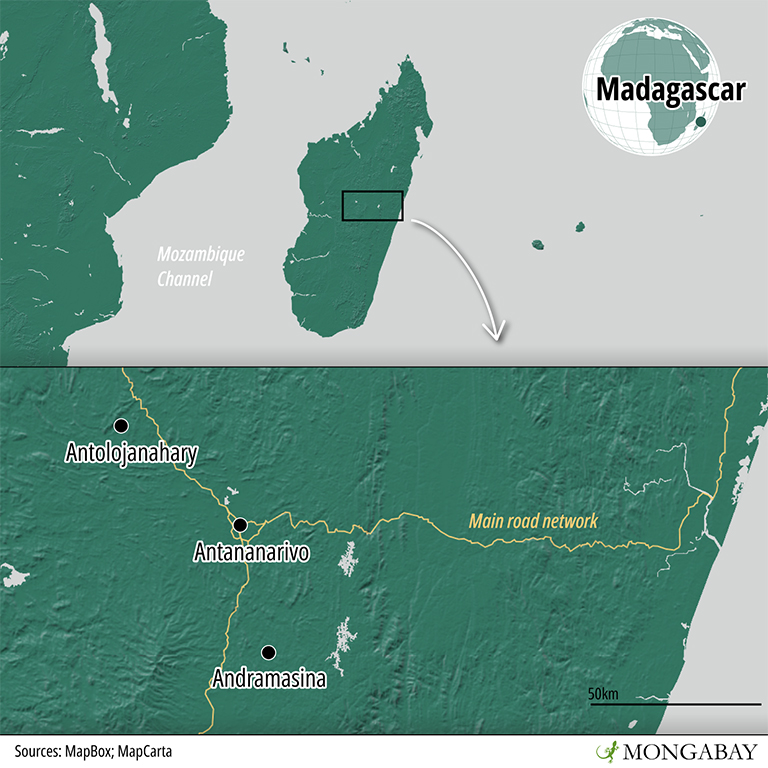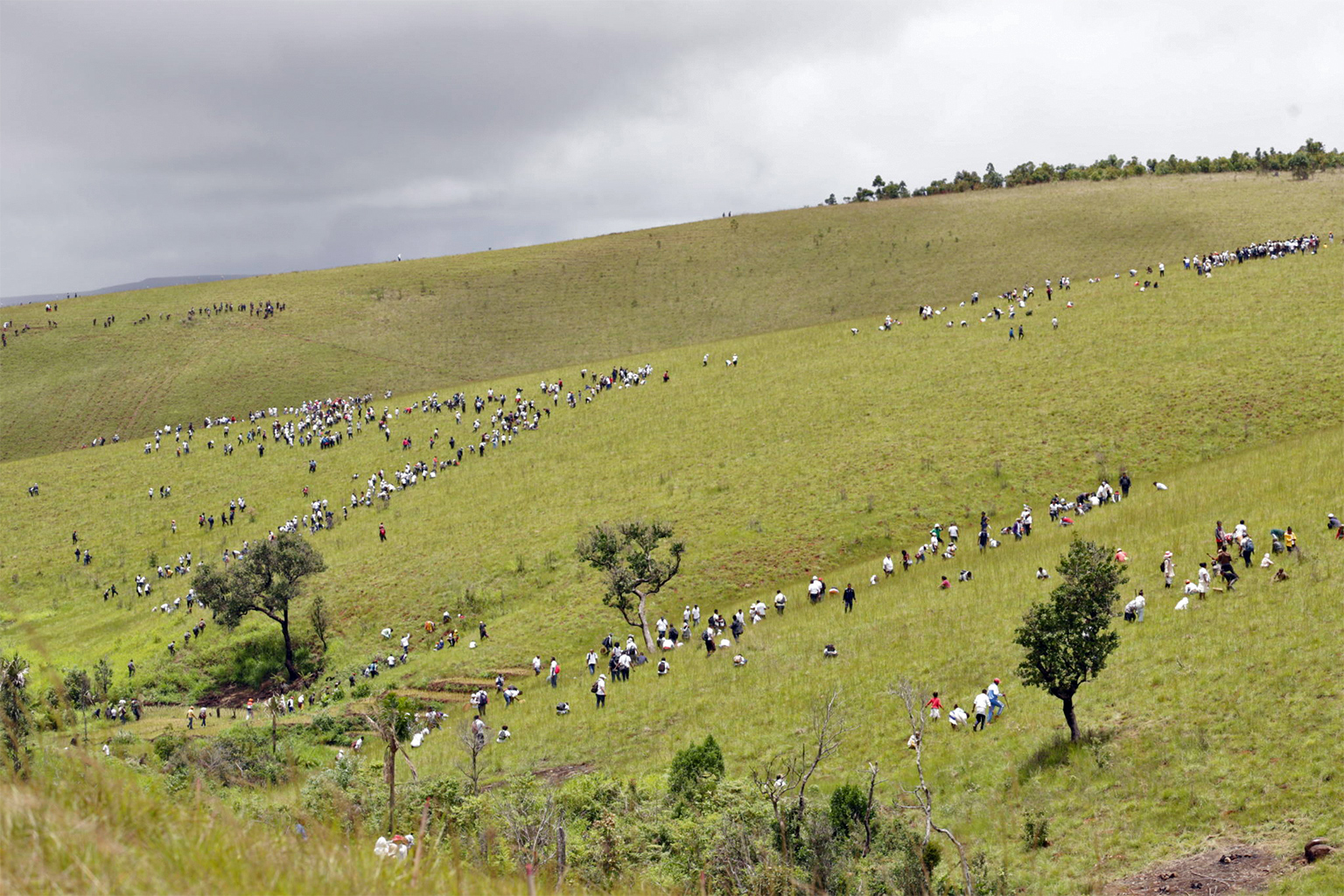Bôndy, a young Malagasy company, has social-impact tree planting at the heart of its “business model.”Bôndy makes money by offering social and environmental responsibility solutions to other companies, by planting trees on farmers’ land on their behalf.Although it has only been operating since 2018, the company’s model is proving successful with both the rural people receiving tree-planting services and the companies financing the projects.Some conservationists, however, are skeptical about the environmental impacts of Bôndy’s approach, which focuses mainly on planting non-native acacia and eucalyptus trees that can be cut for fuel and timber, as well as fruit trees.
ANDRAMASINA, Madagascar — It’s transplanting season in Andramasina’s rice fields. The town is just 40 kilometers (25 miles) south of Madagascar’s bustling capital, Antananarivo, but it takes two and a half hours of driving to get there on poor roads. The town is traversed by the Sisaony River. A destination hiking site for residents of the capital, its water level is abnormally low for December.
“There used to be a lot of water and natural springs in this area,” says Gilbert Randrianarisoa, head nurseryman for the Malagasy company Bôndy. “But deforestation has left the area very dry.”
Now 40, Randrianarisoa spent his childhood in Andramasina in the 1980s and witnessed the landscape deteriorating in front of him. He’s now trying to restore it, little by little, with the trees he grows: more than 186,000 green shoots that line the nursery’s long benches.
Tree planting is being adopted everywhere as an easy solution to restore balance that everyone can contribute to in the face of the global climate emergency. In Madagascar, several groups and companies are starting to grow trees, and are placing tree planting at the heart of their business models. Bôndy is one of them.
The town of Andramasina, 40 kilometers (25 miles) from Antananarivo, as seen from the hill of Ambohimanjaka. Image by Nirina Rakotonanahary for Mongabay.
Max Fontaine, now 26, founded Bôndy in 2018. It works at half a dozen sites, most of them in the Analamanga region, where Andramasina is located. As a social enterprise, it aims to create both positive environmental impacts as well as economic value for farmers participating in its projects.
“Farmers make up the majority but are the least included in society,” Fontaine says. “They are the ones who feed all of Madagascar and also those who suffer the most from climate change.”
Bôndy’s approach is to plant useful trees in deforested rural areas like Andramasina, to enable farmers to earn a living and reduce pressure on remaining forests. These are being cut at a rapid pace across the biodiversity-rich island country as a source of charcoal and building materials and to clear arable land for agriculture. Bôndy makes money by offering social and environmental responsibility solutions to other companies, by reforesting farmers’ land on their behalf.
Although it’s only been operating for a short time, the company’s model is proving successful with both the rural people receiving tree-planting services and the companies financing the projects. The company says it hopes this popularity will help it reach its business targets. However, some conservationists question the environmental impacts of Bôndy’s approach.
 Young persimmon plants in the Bôndy nursery. Image by Nirina Rakotonanahary for Mongabay.
Young persimmon plants in the Bôndy nursery. Image by Nirina Rakotonanahary for Mongabay.
Bôndy’s business model
When launching projects, Bôndy selects rural areas where deforestation has caused profound changes to the landscape. The regions can also be chosen by local personalities, such as the late Michel Domenichini Ramiaramanana, a well-known champion of the Malagasy economy and culture who hailed from Andramasina. Bôndy consults local farmers first to obtain their approval, assess their needs, and go through the terms of the contractual partnership.
In this context of utilitarian reforestation, the trees Bôndy plants, such as Leucaena leucocephala (which has edible shoots), Acacia dealbata and various species of eucalyptus, can be used for fuel or construction. These include fast-growing exotic species, which farmers can use to make charcoal — the primary source of energy in Madagascar, where in 2020 only a third of citizens had access to electricity, according to the World Bank.
Bôndy also plants bamboo species, such as Dendrocalamus strictus, to improve soil fertility and protect against erosion, and fruit trees as cash crops. The company can also cater to farmers’ specific requests: Andramasina farmers have asked for haronga (Harungana madagascariensis), a native tree used in traditional medicine.
Reforestation, as practiced by Bôndy, is different from forest restoration, as it simply involves planting trees raised in nurseries on deforested land, whether the trees are native, exotic, or cultivated in agroforestry systems. Forest restoration, on the other hand, focuses on broader objectives by taking ecosystems into account and aiming to restore what originally existed.
According to Fontaine, there are many reforestation projects in Madagascar, but they lack impact and transparency, which is one reason that motivated him to create Bôndy. The company uses technologies such as GPS and blockchain to monitor its projects, and to guarantee transparency and impact. With these technologies, all tree data from nursery to planting — including plant name, age and size, soil quality, plot boundaries and GPS coordinates, and the farmers who planted them — are stored by the company.
To meet the social and environmental responsibility commitments and the terms of their clients’ contracts, Bôndy monitors tree-planting operations for the duration of the five-year contract, Fontaine says. It takes 10-15% of the financing for its operations, and also aims for returns on investment by later taking a share (about 49%) of the farmers’ crops.
Bôndy counts several large international companies among its clients, such as Lacoste, which, with its Malagasy supplier, Epsilon, supports projects in Antolojanahary, 60 km (37 mi) north of Antananarivo. Nexta, a startup incubator owned by the Axian Group, one of the largest conglomerates in Madagascar, finances Bôndy’s projects in Andramasina. The Axian Group, made up of nearly three dozen companies in Madagascar, including the telecoms company Telma, BNI bank and the industrial group Viseo, is partnering with Bôndy on other tree-planting projects, including one that’s restoring mangroves in Majunga, in northwestern Madagascar. Tamboho Hotels, now owned by the Radisson group, also works with Bôndy in Andramasina.
 The bed of Andramasina’s Sisaony River in December. At this time of year, this portion of the river would normally be rapids. Image by Nirina Rakotonanahary for Mongabay.
The bed of Andramasina’s Sisaony River in December. At this time of year, this portion of the river would normally be rapids. Image by Nirina Rakotonanahary for Mongabay.
Projects mainly focused on social impact
The level of the Sisaony, Andramasina’s main river, was so low that people could easily walk in the canyon that constitutes the riverbed. In the summer month of December, a part of the river traversing a small hill of primary forest would normally be rapids.
Like many regions in Madagascar, Andramasina has seen its agricultural calendar disrupted by drought. To protect yields, people have had to divert some streams and waterways from their usual path, to irrigate rice fields or other areas. Farmers also use the sacred lake of Ambohimanjaka, although it’s artificial, to irrigate the surrounding fields. The lack of trees as a result of logging and land clearing for agricultural plots has silted up the lake and lowered its water level.
Bôndy established its fruit and tree nursery project in Andramasina in part to tackle these issues, Fontaine says. It aims to provide farmers with more income so that they no longer feel the need to exploit the primary forest, as a way to protect biodiversity. Bôndy also plans to limit the sedimentation of the lake by planting native trees around it in the future, according to Fontaine.
Esther Razanamanana, a 69-year-old farmer, says she feels she benefits from the program in Andramasina as she no longer has to pay someone to buy her seedlings at the market or to plant them.
“You know, we will always need it later,” Razanamanana says. “To fertilize the land and green the landscape. Because our land is deteriorating so much that it’s being washed away by runoff.”
According to Rivosoa Marcello Andriamampionona, Bôndy’s technical and operations assistant in Andramasina, the company has partnered with some 40 farmers to plant around 82,000 seedlings since 2020. The survival of seedlings in the face of bad weather, destruction by livestock, or even vandalism, is a challenge, according to Andriamampionona.
 Bôndy nurserymen in the village of Akamasoa Antolojanahary. Image by Nirina Rakotonanahary for Mongabay.
Bôndy nurserymen in the village of Akamasoa Antolojanahary. Image by Nirina Rakotonanahary for Mongabay.
In the village of Antolojanahary, 100 km (60 mi) north of Andramasina, Bôndy has set up a nursery and a tree-planting project that brings together around 70 participating households. Around 10,000 seedlings have been planted since 2020.
The overall survival rate for the trees grown at both nurseries is 60%; trees that don’t survive are replaced during subsequent tree-planting campaigns, according to a Bôndy spokesperson.
Antolojanahary is one of the villages in the Akamasoa association, founded by Argentinian priest Pedro Opeka, one of Madagascar’s most famous charitable figures. The first Akamasoa village was founded in 1989 in Andralanitra, near a gigantic urban dump in Antananarivo, where the poorest survived on foraging in the city’s rubbish. Opeka built a village to offer them a refuge, train them and give them work. Antolojanahary village is an extension of this project. People in Andralanitra selected for their motivation are moved to Antolojanahary to make a living from agriculture.

Bôndy focuses on the social impact of its projects. In this village, the company’s nursery employs three young nurserymen, the only ones employed among the farmers participating in the project. They tend to the young plants for seven hours a day, working toward a target of producing 10,000 tree seedlings per year.
“It suits us because in addition to the harvests, it gave us work,” says Fideranasoa Rakotoarimanana, one of the nurserymen. They plant fruit trees next to their agricultural plots, using agroforestry techniques they learned from Bôndy.
After low rates of tree survival, one of the biggest challenges Bôndy faces is local people’s expectations and attitudes, according to Randrianarisoa, the head nurseryman. “One day I told someone to replace his pines with young plants that are less harmful to the soil. He just told me that his bigger trees were more valuable than the shrubs I was offering him,” he says.
Despite the thousands of trees that Bôndy has planted in Andramasina and Antolojanahary, the plants that are growing are sparse. The trees stand about 2 meters (6.5 feet) tall on average, and are about 2 years old.
“That’s agroforestry, the trees have to be spaced 2 meters apart,” Fontaine says. “People think that when we plant trees, we’ll end up with a mini forest with trees very close to each other. We want to change this vision of tree planting.”
 Bôndy’s nursery in the village of Akamasoa Antolojanahary. Image by Nirina Rakotonanahary for Mongabay.
Bôndy’s nursery in the village of Akamasoa Antolojanahary. Image by Nirina Rakotonanahary for Mongabay.
What about ecosystems?
Bôndy’s business goals could come at the expense of its avowed commitment to biodiversity and ecosystem restoration. In addition to fruit trees, the company mainly plants exotic species that aren’t necessarily compatible with its objective of improving biodiversity or combating drought, experts say.
“These trees will not necessarily contribute to the conservation of native biodiversity and could not really be called ‘restoration,’ because they do not restore what existed before,” says Christian Kull, a professor at the University of Lausanne’s Institute of Geography and Sustainability and an expert in Madagascar’s ecosystem landscapes.
Scientists are particularly concerned about the use of exotic monocultures for tree planting. Although Bôndy varies the species it plants to avoid monocultures, it doesn’t plant many native species, at least not yet.
In the long term, restored native forests maximize biomass and capture much more carbon while preserving biodiversity, according to a study published in 2021 in the journal Global Change Biology. They can also generate economic benefits for local communities. Exotic species risk becoming invasive, reducing organic carbon in the soil and harming pollinators, among other potential risks listed in the study.
Bôndy and other tree-planting projects value Acacia dealbata and its fellow legume-family tree Leucaena leucocephala for their utility and rapid growth, but in other countries they’re considered invasive species. L. leucocephala is on the IUCN list of the world’s 100 most invasive foreign species.
It’s crucial not to plant acacias and eucalyptus at high altitudes or near water sources, as the roots of these trees can grow very deep into the ground to draw water, according to Nicolas Naina Rasolonjatovo, head of the reforestation department at Centre ValBio, a research institute near Ranomafana National Park in southeastern Madagascar. These types of trees have a reputation for depleting water sources — a particular problem in Andramasina and Antolojanahary.
 Participants at a tree-planting event in Ankazobe district, Madagascar, on Jan. 19, 2020. The planting marked the launch of a major government tree-planting campaign. Image by Valisoa Rasolofomboahangy for Mongabay.
Participants at a tree-planting event in Ankazobe district, Madagascar, on Jan. 19, 2020. The planting marked the launch of a major government tree-planting campaign. Image by Valisoa Rasolofomboahangy for Mongabay.
There is also a risk of displacing native biodiversity, especially through the modification of non-forest ecosystems. It’s possible that the Andramasina and Antolojanahary regions were never originally covered with forests, despite popular belief. Malagasy researchers have demonstrated that the central highlands of Madagascar, which are largely in Analamanga, probably weren’t originally covered with forest, but partly with grasslands. Their 2020 study found that not only is their replacement with exotic tree species damaging, but on a large scale it would reduce the flow of rivers, with unknown environmental consequences in the context of a changing climate. These native grasslands would be better carbon sinks than new forests.
Like many Malagasy people and even Andramasina locals, Fontaine says he firmly believes that the highlands of Madagascar were once almost entirely covered in lush primary forests. He also says that unlike forest restoration, it’s fine for reforestation projects to plant trees in areas with no original forest cover.
“As long as you factor in the surrounding ecosystems when choosing which species to plant, you can mitigate the risks,” he says.
Bôndy isn’t the only company to have adopted this approach. Tree planting has become widespread in the Madagascar highlands, especially since the Malagasy government launched a campaign in 2020 that mixes exotic and native species. Centre ValBio’s Rasolonjatovo maintains that this practice should be avoided, as foreign species risk destroying native trees, which are fragile and take a long time to grow.
There’s also the issue of carbon sequestration, which seems to be part of what attracts Bôndy’s corporate clients. “The team’s ‘one tree planted = one tree grown’ slogan convinced us that their sustainable model of integrating stakeholders and closely monitoring progress would guarantee the creation of promised carbon sinks,” says Fanilo Rakotovao Rakotoarison, social impact director for the Axian Group.
However, Fontaine is cautious about guaranteeing carbon sequestration in Bôndy’s projects. “We don’t make any carbon sequestration guarantees, as companies are not paying us for that,” he says. According to him, Bôndy’s carbon sequestration methods are still being analyzed by researchers at the University of Antananarivo’s College of Agricultural Sciences, and he says he doesn’t want to offer these services before the methods get the green light.
 Bôndy’s tree nursery in Andramasina. Image by Nirina Rakotonanahary for Mongabay.
Bôndy’s tree nursery in Andramasina. Image by Nirina Rakotonanahary for Mongabay.
In any case, the impact would be minimal because Bôndy focuses mainly on practical tree-planting projects with trees intended to be used for wood or fruit trees. “So it doesn’t make sense to talk about carbon sequestration,” Rasolonjatovo says.
Despite the company’s youth and the questions about its environmental effectiveness, a lot of hope rests on Bôndy. The company was even appointed by the environment ministry to represent Malagasy youth at the COP26 U.N. climate summit in Glasgow, Scotland, in 2021. The word Bôndy means a “million” in Malagasy slang; the company adopted this name as a symbol of its ambitious tree-planting goals.
Banner image: Bôndy nurserymen tending to eucalyptus saplings in Andramasina. Image by Nirina Rakotonanahary for Mongabay.
This article was first published on Mongabay’s French website here on Aug. 3, 2022.
Citations :
Di Sacco, A., Hardwick, K. A., Blakesley, D., Brancalion, P. H., Breman, E., Cecilio Rebola, L., … Antonelli, A. (2021). Ten golden rules for reforestation to optimize carbon sequestration, biodiversity recovery and livelihood benefits. Global Change Biology, 27(7), 1328-1348. doi:10.1111/gcb.15498
Solofondranohatra, C. L., Vorontsova, M. S., Hempson, G. P., Hackel, J., Cable, S., Vololoniaina, J., & Lehmann, C. E. (2020). Fire and grazing determined grasslands of central Madagascar represent ancient assemblages. Proceedings of the Royal Society B: Biological Sciences, 287(1927), 20200598. doi:10.1098/rspb.2020.0598
FEEDBACK: Use this form to send a message to the editor of this post. If you want to post a public comment, you can do that at the bottom of the page.
Afforestation, Agriculture, Agroforestry, Biodiversity, Business, Community-based Conservation, Conservation, Ecological Restoration, Environment, Forestry, Forests, Landscape Restoration, Reforestation, Restoration, Trees
Africa, East Africa, Madagascar
Source link : https://news.mongabay.com/2022/10/in-madagascar-a-tree-planting-business-goes-long-on-social-short-on-eco/
Author :
Publish date : 2022-10-10 07:00:00
Copyright for syndicated content belongs to the linked Source.





